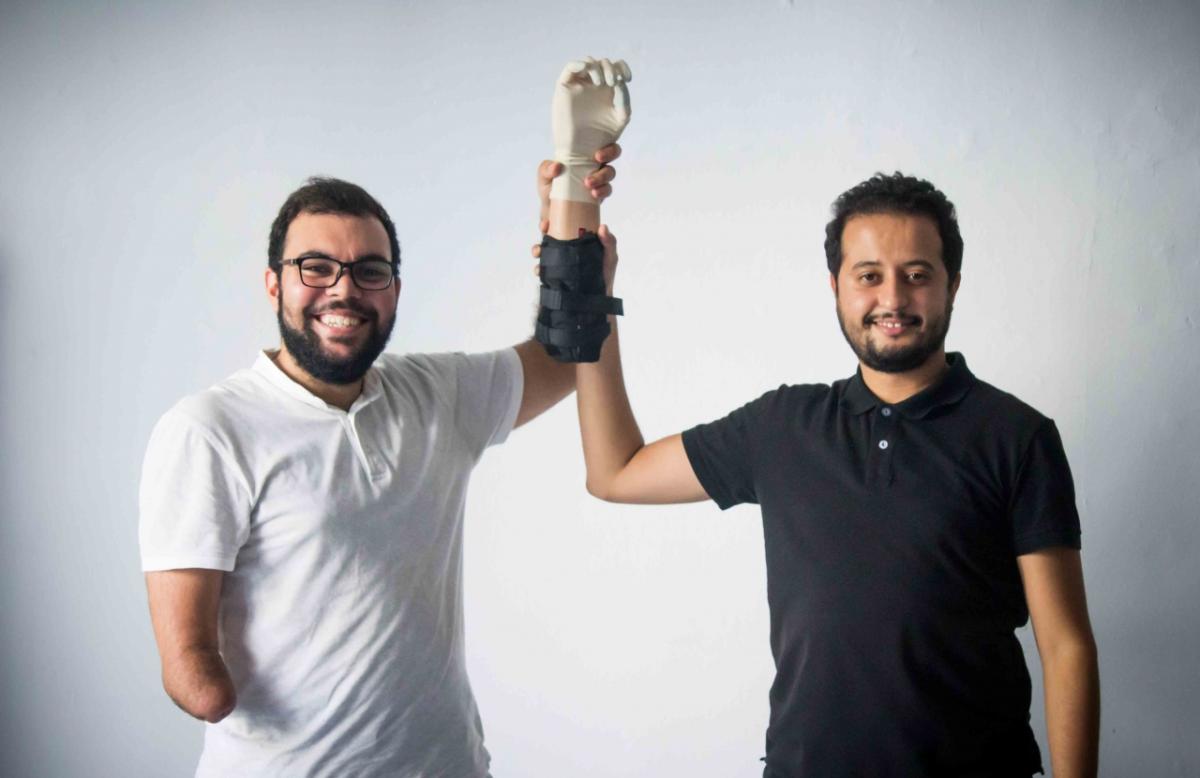Meet CURE: First Runner-Up of the Cisco Global Problem Solver Challenge 2020

Cisco Blogs | Corporate Social Responsibility
Now that the Cisco Global Problem Solver Challenge 2020 winners have been officially announced, you’ll want to learn more about each winning team and the story behind each innovation. In its fourth year, this online competition awards cash prizes to early-stage startups to develop a solution that drives economic development or solves a social or environmental problem.
We are excited for you to learn more about the 2020 winning teams addressing some of the biggest challenges we face through technology-based solutions. I had the chance to speak with CURE founder, Mohamed Dhaouafi, winner of the First Runner-Up $75,000 USD prize.
What problem is your technology solution trying to solve?Dhaouafi: Our goal is to empower people with disabilities. And we are currently focusing on those with limb differences by providing them with 3D printed bionic arms, hands, etc. There are approximately 30 million people around the world with limb differences and only five percent of them are fitted with prosthetic devices. That’s a huge gap.
Besides reducing physical function, limb difference also has many secondary effects. For example, most children missing a limb never complete primary school, and most of those with limb differences, particularly in developed countries, are unemployed. It also impacts their ability to get married, have a family, etc. Its impacts, really, are very far reaching.
What inspired you to develop this solution?Dhaouafi: I was not conscious about it when it started. It all began when I participated in a student challenge with some friends. We were trying to develop a platform or a marketplace for medical devices, and one of my team members mentioned his cousin who was born with no hands. And he recommended we add prosthetics to the marketplace, given the millions of people in need. That’s when we started asking questions about the reason for not having prosthetics. And that’s when the seed was planted, and I felt that it was my purpose in life.
Unfortunately, we didn’t continue the work together. But I took the project on for my graduation project. During that time, I met with that eight-year-old boy in need of a prosthetic hand, therapy, and some support. That child’s family was unable to provide him with prosthetics, and I was unable to help him – leaving me feeling even more disabled than he might’ve felt. That’s when I promised myself to do everything I could to help improve the lives of people with limb differences.
Can you explain how the solution works?
Dhaouafi: Using a 3D printer, we create bionic prosthetics powered by batteries. When we first started in 2017, we were using mechanical prosthetics that were not practical, hard to use, and weren’t as functional as our users needed. So, we added EMG sensors that are put on the skin – with no surgical intervention – that detect the muscles’ electrical activity, which causes the prosthetic to respond. So, whenever a person contracts their muscles to grab something the prosthetic contracts. Now we have something easy to make and easy to control.
Then we found that most children do not get a prosthetic until they are around 20 years old, because they grow out of their prosthetic so quickly. And, on average, a child will need at least ten prosthetic devices in their first 21 years, costing more than $100,000 USD. We solved that problem by making [our prosthetics] adjustable.
Data shows that around 70 percent of people with limb differences are not satisfied with their prosthetics, and for that, our prosthetics are continuously customizable – by just changing removable custom covers with cool designs, such as a superhero designs. So, by providing them with a customizable design – for example, for Halloween – they are excited to show off their difference. We want people with limb differences to be proud of and happy to show their differences.
Also, many developed countries in Africa, Asia, and Latin American don’t have stable access to electricity – making it a challenge to keep prosthetics charged. So, we are developing an easy-to-use wireless charger that uses solar energy.
Additionally, we created a therapeutic solution using virtual reality and gamification. It was inspired by an eight-year-old boy I met who lost his hand from electrical shock. He was really traumatized by the loss, so I wanted to create a therapy that wasn’t only effective, but fun. For children, it’s all about play.
It’s simple. The users wear a bracelet with sensors in it and a virtual reality headset, and the program leads them through fun games that simulate therapeutic exercises. For example, a game that imitates Spiderman makes the patient jump from one building to another – each time they contract their muscles, [they] get points and bonuses for each activity. It all can be done at home, with an online real-time follow-up with a doctor.
How will winning a prize in the Cisco Global Problem Solver Challenge help you advance your business?Dhaouafi: Winning the First Runner-Up prize in the Challenge will help us advance our business in so many ways. First, it is helping us expand our partnerships [within] the Cisco community. Second, it is bringing us much-needed exposure. In fact, CNN has already contacted us. It also allows us to accelerate our process and operations. We have been trying to buy 3D printers – and now we can. We need a new office space – and now that is possible. Lastly, I believe it will allow us to implement the right marketing strategy. One based on powerful storytelling and the inspiring stories of our users. This prize will also help us get the needed materials, finalize clinical trials, get certifications, and go to market.
How has the global pandemic impacted your work?Dhaouafi: The good part of the pandemic is that it has shown that start-ups are the real solution for today’s challenges. And it showed that telemedicine is the new thing. We are also getting interest from potential clients and partners. The bad part is that this pandemic has slowed down our operations. We import a lot of things. Some things we could not get at all. We also could not do clinical trials. People did not want to come out, and hospitals were overwhelmed.
Why did you decide to start your own social enterprise versus going to work for a company?Dhaouafi: I like getting out of my comfort zone. I participated in a challenge at my school, the Ecole Nationale d’Ingénieurs de Sousse (ENISo), and then later the Tunis Business School. After that, I participated in an international exchange program called Middle East Partnership Initiative (MEPI), where I was in the United States for six weeks. As part of the program, we took a social entrepreneurship class, which was a great mix of inspired people.
In fact, it all started when I failed my first year of engineering and started asking existential questions about my life and my role in this world. That led me to get out of my comfort zone and to participate in several programs and opportunities during my engineering studies at ENISo. I also took part in the MEPI Student Leaders Program, where I spent six weeks in the U.S., studying at Montana State University, and where I met with inspiring leaders from all over the Middle East and Africa. All of that inspired me to be a better version of myself. That was my first inspiring community.
When I went back to my country, I was not the same person. I wanted to do something with purpose and that’s why I am working hard on my startup today.
What is the best piece of advice you received about starting your social enterprise?Dhaouafi: Have a mission and focus on long-term impact, and you will attract the right partners, resources, and opportunities – rather than focusing on the short-term results, because you will face a lot of obstacles, challenges, and disappointments.
That’s the advice President Obama gave us when we recently had our Obama Foundation Africa Leaders call with him.
Do you have any advice for next year’s applicants?Dhaouafi: Do not talk about what you are doing – talk about why you are doing it and what impact it will bring to your target community.
What job would you be doing if you did not do this?Dhaouafi: I do not see myself doing something else. But if I completed my work, I would like to work for an NGO that provides services to people with disabilities.
What is your favorite book and why?Dhaouafi: My favorite book is Find Your Why? by Simon Senik. This book is designed to inspire people to do what they love by finding their why. It’s all about finding our why and bringing it to life, both personally and professionally.
What is your favorite activity when you are not working?Dhaouafi: When I am not working, I have two main activities – fishing and playing video games. They are both challenging and complementary for me.
Stay tuned for more articles in our blog series, featuring interviews with every Cisco Global Problem Solver Challenge 2020 winning team!

